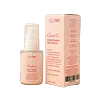What's inside
What's inside
 Key Ingredients
Key Ingredients

 Benefits
Benefits

 Concerns
Concerns

No concerns
 Ingredients Side-by-side
Ingredients Side-by-side

Water
Skin ConditioningHippophae Rhamnoides Fruit Extract
Skin ConditioningGlycerin
HumectantMethylpropanediol
SolventCaprylic/Capric Triglyceride
MaskingCyclopentasiloxane
EmollientNiacinamide
SmoothingBetaine
HumectantCitrus Limon Fruit Extract
MaskingPunica Granatum Fruit Extract
AntioxidantSalix Alba Bark Extract
AstringentMalpighia Emarginata Fruit Extract
Skin ConditioningTerminalia Ferdinandiana Fruit Extract
AntioxidantPortulaca Oleracea Extract
Skin ConditioningCitrus Paradisi Fruit Extract
Skin ConditioningSodium Hyaluronate
HumectantPanthenol
Skin ConditioningXylitol
HumectantAllantoin
Skin ConditioningAscorbic Acid
AntioxidantAscorbyl Glucoside
AntioxidantTetrahexyldecyl Ascorbate
AntioxidantSodium Riboflavin Phosphate
Skin ConditioningSodium Ascorbyl Phosphate
AntioxidantMagnesium Ascorbyl Phosphate
AntioxidantMenadione
MaskingGlutathione
Zea Mays Starch
AbsorbentMannitol
HumectantSucrose
HumectantAdenosine
Skin ConditioningButylene Glycol
HumectantCaprylyl Glycol
EmollientIsohexadecane
EmollientCyclohexasiloxane
EmollientDimethicone
EmollientCetearyl Glucoside
EmulsifyingSorbitan Olivate
EmulsifyingCetearyl Alcohol
EmollientSorbitan Oleate
EmulsifyingPolysorbate 80
EmulsifyingXanthan Gum
EmulsifyingMicrocrystalline Cellulose
AbsorbentSodium Acrylate/Sodium Acryloyldimethyl Taurate Copolymer
Emulsion StabilisingGlyceryl Acrylate/Acrylic Acid Copolymer
HumectantAmmonium Acryloyldimethyltaurate/Vp Copolymer
Sodium Polyacrylate
AbsorbentDimethicone/Vinyl Dimethicone Crosspolymer
Skin Conditioning1,2-Hexanediol
Skin ConditioningBenzyl Glycol
SolventEthylhexylglycerin
Skin ConditioningRaspberry Ketone
MaskingDisodium EDTA
CI 77891
Cosmetic ColorantCI 77492
Cosmetic ColorantCitrus Limon Peel Oil
MaskingCitral
PerfumingLimonene
PerfumingWater, Hippophae Rhamnoides Fruit Extract, Glycerin, Methylpropanediol, Caprylic/Capric Triglyceride, Cyclopentasiloxane, Niacinamide, Betaine, Citrus Limon Fruit Extract, Punica Granatum Fruit Extract, Salix Alba Bark Extract, Malpighia Emarginata Fruit Extract, Terminalia Ferdinandiana Fruit Extract, Portulaca Oleracea Extract, Citrus Paradisi Fruit Extract, Sodium Hyaluronate, Panthenol, Xylitol, Allantoin, Ascorbic Acid, Ascorbyl Glucoside, Tetrahexyldecyl Ascorbate, Sodium Riboflavin Phosphate, Sodium Ascorbyl Phosphate, Magnesium Ascorbyl Phosphate, Menadione, Glutathione, Zea Mays Starch, Mannitol, Sucrose, Adenosine, Butylene Glycol, Caprylyl Glycol, Isohexadecane, Cyclohexasiloxane, Dimethicone, Cetearyl Glucoside, Sorbitan Olivate, Cetearyl Alcohol, Sorbitan Oleate, Polysorbate 80, Xanthan Gum, Microcrystalline Cellulose, Sodium Acrylate/Sodium Acryloyldimethyl Taurate Copolymer, Glyceryl Acrylate/Acrylic Acid Copolymer, Ammonium Acryloyldimethyltaurate/Vp Copolymer, Sodium Polyacrylate, Dimethicone/Vinyl Dimethicone Crosspolymer, 1,2-Hexanediol, Benzyl Glycol, Ethylhexylglycerin, Raspberry Ketone, Disodium EDTA, CI 77891, CI 77492, Citrus Limon Peel Oil, Citral, Limonene
Water
Skin ConditioningSodium Ascorbyl Phosphate
AntioxidantSodium Lactate
BufferingSodium Glutamate
MaskingGlycyrrhiza Glabra Root Extract
BleachingZiziphus Jujuba Fruit Extract
Skin ConditioningArtemisia Capillaris Flower Extract
Skin ConditioningScutellaria Baicalensis Root Extract
AstringentMorus Alba Root Extract
BleachingPunica Granatum Flower Extract
Skin ConditioningSodium Hyaluronate
HumectantButylene Glycol
HumectantXanthan Gum
EmulsifyingMaltodextrin
AbsorbentEthylhexylglycerin
Skin ConditioningPhenoxyethanol
PreservativeSodium Citrate
BufferingWater, Sodium Ascorbyl Phosphate, Sodium Lactate, Sodium Glutamate, Glycyrrhiza Glabra Root Extract, Ziziphus Jujuba Fruit Extract, Artemisia Capillaris Flower Extract, Scutellaria Baicalensis Root Extract, Morus Alba Root Extract, Punica Granatum Flower Extract, Sodium Hyaluronate, Butylene Glycol, Xanthan Gum, Maltodextrin, Ethylhexylglycerin, Phenoxyethanol, Sodium Citrate
Ingredients Explained
These ingredients are found in both products.
Ingredients higher up in an ingredient list are typically present in a larger amount.
Butylene Glycol (or BG) is used within cosmetic products for a few different reasons:
Overall, Butylene Glycol is a safe and well-rounded ingredient that works well with other ingredients.
Though this ingredient works well with most skin types, some people with sensitive skin may experience a reaction such as allergic rashes, closed comedones, or itchiness.
Learn more about Butylene GlycolEthylhexylglycerin (we can't pronounce this either) is commonly used as a preservative and skin softener. It is derived from glyceryl.
You might see Ethylhexylglycerin often paired with other preservatives such as phenoxyethanol. Ethylhexylglycerin has been found to increase the effectiveness of these other preservatives.
Sodium Ascorbyl Phosphate is a form of Vitamin C. It is the salt of ascorbic acid.
This ingredient is more gentle than ascorbic acid. It is also more stable when exposed to light and oxygen.
Vitamin C helps reduce redness, improve skin texture, reduce the effects of aging, reduce the visibility of dark spots, and brighten skin.
Your skin uses Vitamin C to produce collagen and collagen production plays a role in having a strong skin barrier and plump skin. As an antioxidant, this ingredient also helps reduce the signs of aging such as fine-lines and wrinkles.
VItamin C helps brighten skin by blocking the process of skin darkening.
In a 2011 study, Sodium Ascorbyl Phosphate was found to have antibacterial properties. This may help treat acne.
Read more about other types of Vitamin C:
Learn more about Sodium Ascorbyl PhosphateSodium Hyaluronate is hyaluronic acid's salt form. It is commonly derived from the sodium salt of hyaluronic acid.
Like hyaluronic acid, it is great at holding water and acts as a humectant. This makes it a great skin hydrating ingredient.
Sodium Hyaluronate is naturally occurring in our bodies and is mostly found in eye fluid and joints.
These are some other common types of Hyaluronic Acid:
Learn more about Sodium HyaluronateWater. It's the most common cosmetic ingredient of all. You'll usually see it at the top of ingredient lists, meaning that it makes up the largest part of the product.
So why is it so popular? Water most often acts as a solvent - this means that it helps dissolve other ingredients into the formulation.
You'll also recognize water as that liquid we all need to stay alive. If you see this, drink a glass of water. Stay hydrated!
Learn more about WaterXanthan gum is used as a stabilizer and thickener within cosmetic products. It helps give products a sticky, thick feeling - preventing them from being too runny.
On the technical side of things, xanthan gum is a polysaccharide - a combination consisting of multiple sugar molecules bonded together.
Xanthan gum is a pretty common and great ingredient. It is a natural, non-toxic, non-irritating ingredient that is also commonly used in food products.
Learn more about Xanthan Gum